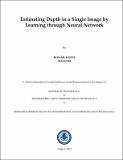Estimating depth in a single image by learning through neural networks
Abstract
Depth information extraction from images is a vibrant problem in computer vision. Features from the image like: haze, texture gradient and texture variation could give depth-related knowledge. Typically, input features are provided to the machine through images or video sequences. There are methods which are able to find depth through multiple images. These methods rely on correlated information present in those images. Such correlation is difficult with single images and hence to extract depth from a single image, help is taken from different priors. Image geometry, relative motion of different objects, defocus cues are a few of those priors. Parameters that infer depth are learned through training. Neural Networks, that are good learners, are employed to acquire these parameters through supervised learning.
First approach in this thesis models depth estimation task as a classification problem. The depth range is initially divided to binary levels, viz., near and far. A class of Neural Networks called Multilayer Perceptrons (MLP) are used as classifiers to classify depths given image features. In the second approach, Neural Networks are employed to learn the unknown relationship between image features and their corresponding depth. Once the parameters are learned, they are used to estimate the depth for a test image.
Features are extracted form the images. The features along with their corresponding depths are trained with different configurations of the Neural Network. The results are compared with true depth maps. Reasoning for the quality of outcomes is then summarily given.
Collections
- M Tech Dissertations [923]

